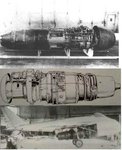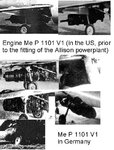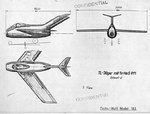- Thread starter
- #141
Twitch
Staff Sergeant
Let's not forget the variation of engine thrusts at work here. The Jumo 004-B of 1,980-lbs. thrust was the initial one to be used but the proposed final power was to be the Heinkel 109- 011 or HeS 11. Not the 2,460-lb thrust engine but the eventual 3,520 lb- thrust turbine that was being worked up to production viability. The P.1101 was among many 2nd generation jets that would have used the HeS 11 in the near future. The power was at hand.
And the reality of things are that the P.1101 was sent to the US and many of its actual components were used in the X-5! It used a 4,900-lb thrust engine and incorporated a variable sweep wing. The P.1101 was not variable in flight. The X-5 maxed out at 650 MPH 60° swept and 605 MPH 20° unswept at 9,892 lbs.
Any speed in the ranges of 650 MPH projected for the P.1101 was at the very onset of the project before modifications and strengthening added weight. See these are the things that reality dictates after best projected estimates are done. Modifications are always needed. But estimating speed with thrust and weight factors that change requires re-assessment of performance. Would a lighter P.1101 with 3,520 lbs thrust have done 650 MPH? Certainly a heavier P.1101 with less thrust wasn't able to.
Here's what I have gleaned on the P.1101 with the bottom line of the design being sound and far from a doodle on paper.
P.1101
Messerschmitt had its P.1101 80% complete when American troops over ran the Oberammergau assembly complex in late April 1945. A Jumo 004B was installed but specs called for the forthcoming He S 011 of greater thrust which was expected to propel the fighter to speeds of 650-670 MPH between 20-23,000 feet with a range of some 930 miles. Weights were estimated at 6,600-7,200 lbs. Armament considered was two or three Mk 108 30 mm cannon and four of the new X-4 air-to-air wire-guided missiles. Of note were the swept wings that could be adjusted on the ground for variable sweep settings of 35 or 45 degrees. Their span was only 23.5 feet.
The P.1101 design lacked only an engine powerful enough to propel it when its layout was drawn up in 1942. It sat on the drawing board until the HeS evolved. It was problem-ridden in its early stages, as are most prototypes. Modifications continued until the end though and the plane would have been easy to maintain with good access to the one turbojet. Originally a 650-670 MPH speed was anticipated but estimates of about 550-612 MPH were calculated after all the modifications and strengthening changes were made. The five Mk 108 30 mm cannon in the nose caused a space problem adjacent to the intake and spent shell chutes were problematic. Finally weighing 8,966 lbs., the P.1101 would have climbed at 4,370 FPM and had a maximum range of 932 miles and a 45,933-foot ceiling.
The Bell X-5 high-speed research craft was designed directly from the captured P.1101's layout. Certainly the X-5 proved the design in its flights.
The P.1101 is another plane that could have soon been in production and would have been a concern for the Allies.
And the reality of things are that the P.1101 was sent to the US and many of its actual components were used in the X-5! It used a 4,900-lb thrust engine and incorporated a variable sweep wing. The P.1101 was not variable in flight. The X-5 maxed out at 650 MPH 60° swept and 605 MPH 20° unswept at 9,892 lbs.
Any speed in the ranges of 650 MPH projected for the P.1101 was at the very onset of the project before modifications and strengthening added weight. See these are the things that reality dictates after best projected estimates are done. Modifications are always needed. But estimating speed with thrust and weight factors that change requires re-assessment of performance. Would a lighter P.1101 with 3,520 lbs thrust have done 650 MPH? Certainly a heavier P.1101 with less thrust wasn't able to.
Here's what I have gleaned on the P.1101 with the bottom line of the design being sound and far from a doodle on paper.
P.1101
Messerschmitt had its P.1101 80% complete when American troops over ran the Oberammergau assembly complex in late April 1945. A Jumo 004B was installed but specs called for the forthcoming He S 011 of greater thrust which was expected to propel the fighter to speeds of 650-670 MPH between 20-23,000 feet with a range of some 930 miles. Weights were estimated at 6,600-7,200 lbs. Armament considered was two or three Mk 108 30 mm cannon and four of the new X-4 air-to-air wire-guided missiles. Of note were the swept wings that could be adjusted on the ground for variable sweep settings of 35 or 45 degrees. Their span was only 23.5 feet.
The P.1101 design lacked only an engine powerful enough to propel it when its layout was drawn up in 1942. It sat on the drawing board until the HeS evolved. It was problem-ridden in its early stages, as are most prototypes. Modifications continued until the end though and the plane would have been easy to maintain with good access to the one turbojet. Originally a 650-670 MPH speed was anticipated but estimates of about 550-612 MPH were calculated after all the modifications and strengthening changes were made. The five Mk 108 30 mm cannon in the nose caused a space problem adjacent to the intake and spent shell chutes were problematic. Finally weighing 8,966 lbs., the P.1101 would have climbed at 4,370 FPM and had a maximum range of 932 miles and a 45,933-foot ceiling.
The Bell X-5 high-speed research craft was designed directly from the captured P.1101's layout. Certainly the X-5 proved the design in its flights.
The P.1101 is another plane that could have soon been in production and would have been a concern for the Allies.




